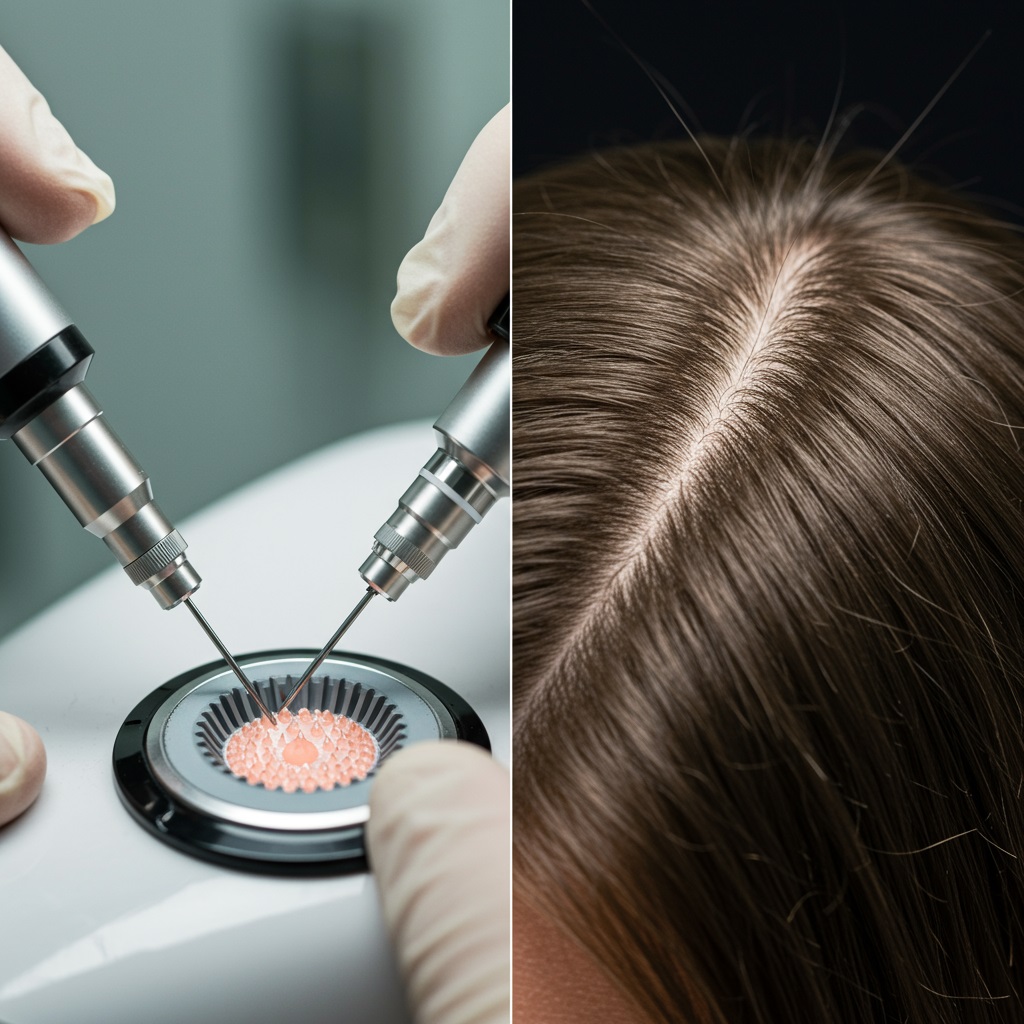🔬 The Initial Clinical Assessment
Initially, every successful transformation depends on a thorough medical evaluation. During this stage, the surgeon analyzes the density of your donor area. In addition, they check for skin elasticity and the specific type of hair you possess. If the donor area lacks sufficient follicles, the doctor might suggest alternative therapies. Conversely, healthy candidates move forward to the design phase. This careful planning ensures that the final result looks completely natural and harmonious.
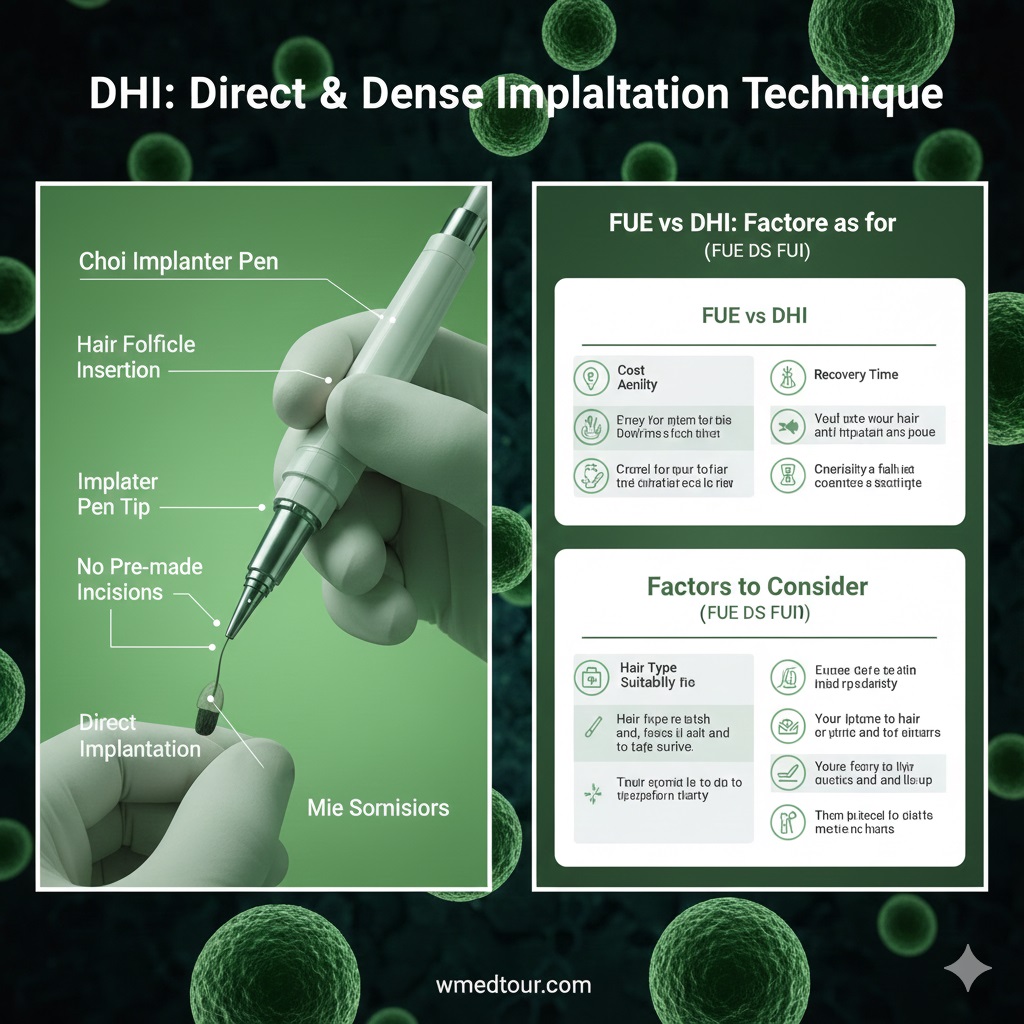
📐 Designing a Natural Hairline
Designing the hairline is perhaps the most artistic part of the hair transplant procedure step by step. Specifically, the surgeon must consider your facial symmetry. They draw a boundary that mimics the natural irregularities of a youthful hairline. Moreover, they avoid creating a “straight line,” which often looks artificial. Subsequently, the medical team prepares the scalp by shaving or trimming the hair. While some prefer the “unshaven” look, trimming often allows for higher precision during the extraction phase.
🚜 Phase One: Extraction Techniques
Once the anesthesia takes effect, the extraction begins in earnest. During this period, the medical team uses a micro-motor punch tool. This device carefully isolates individual follicular units. Furthermore, the surgeon must maintain a specific angle to avoid damaging the hair roots. Because the health of the graft is paramount, the harvested follicles are immediately stored in a chilled solution. This step prevents dehydration and increases the eventual success rate of the transplant.
🧊 Preserving the Harvested Grafts
Actually, the time a graft spends outside the body is critical. Therefore, clinics use special storage fluids enriched with nutrients. While the extraction continues, the surgical assistants sort the grafts by the number of hairs they contain. For instance, single-hair grafts are reserved for the front hairline. On the other hand, multi-hair grafts provide the density needed for the crown area. As a result, the distribution of hair appears uniform and realistic once growth begins.
✂️ Method 1: Follicular Unit Extraction (FUE)
FUE is currently the most widely used hair transplant procedure step by step. In this method, the surgeon opens channels in the recipient area using sapphire or steel blades. Following this, they manually place each graft into these tiny incisions. Although this process takes several hours, it allows for high-volume coverage. For those seeking extensive restoration, FUE remains the most efficient choice. You can learn more about this at skin and hair centers globally.
📉 Pros and Cons of FUE
One major benefit is that FUE leaves virtually no visible scarring. Specifically, it creates tiny circular marks that fade within weeks. However, the procedure typically requires a fully shaven head. In addition, the separate “channel opening” phase can cause slightly more bleeding compared to other methods. Nevertheless, its reliability makes it a favorite among top hair surgeons. According to data from ISHRS, FUE accounts for over 70% of global transplants.
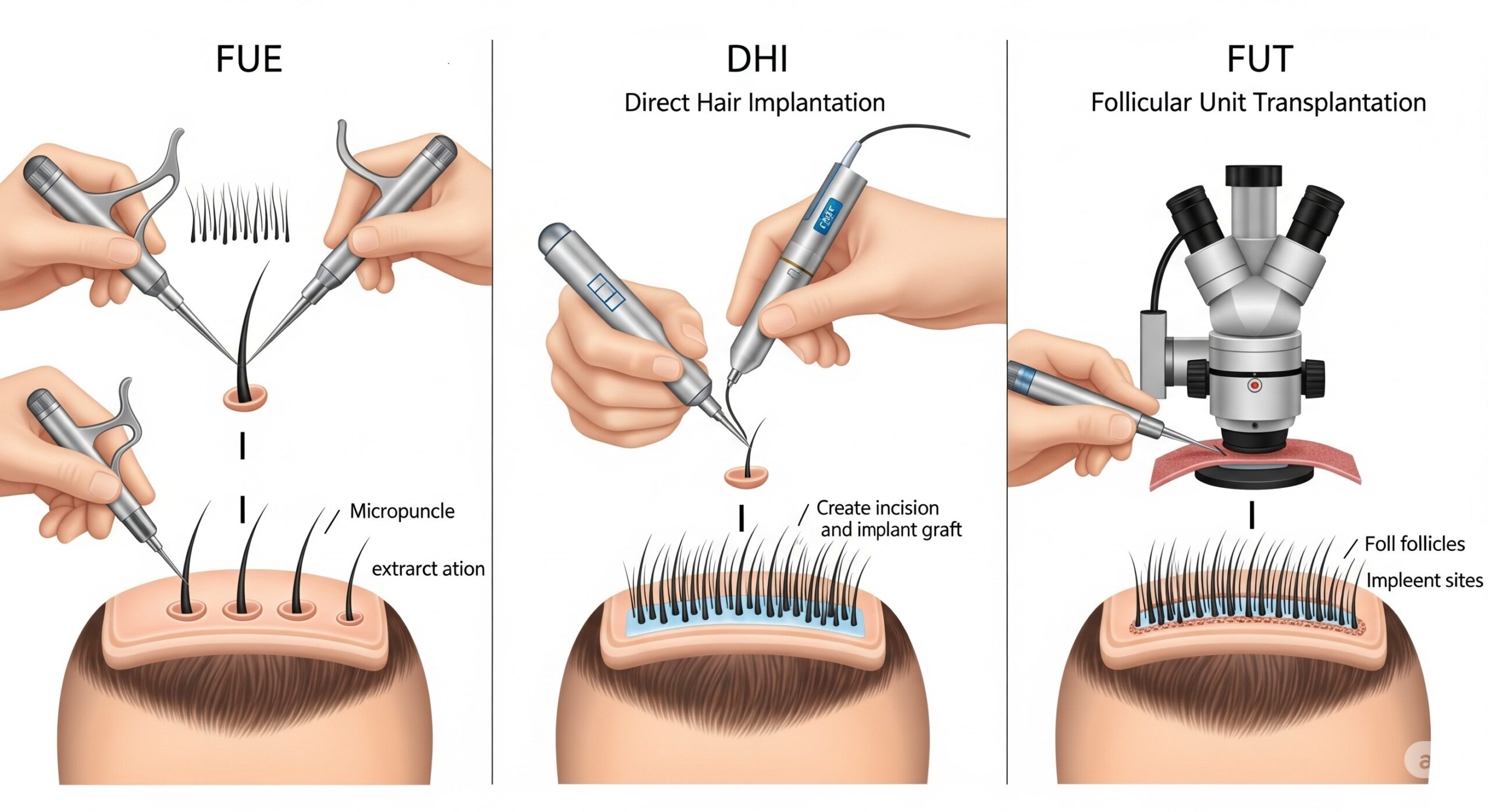
🖋️ Method 2: Direct Hair Implantation (DHI)
In contrast to FUE, the DHI method utilizes the Choi Implanter Pen. This sophisticated tool allows the surgeon to perform extraction and implantation almost simultaneously. Because the implanter pen controls depth and direction, the results are incredibly precise. Furthermore, DHI often eliminates the need for a full shave. Consequently, this technique is very popular among women and professionals who wish to return to work quickly without a visible change in their hairstyle.
📈 Pros and Cons of DHI
The primary advantage of DHI is the increased hair density it provides. Also, the recovery time is slightly shorter due to the lack of pre-opened channels. On the downside, DHI is often more expensive than FUE. Furthermore, it is generally limited to around 2,500 grafts per session. Therefore, if you require a very large transplant, FUE might be more appropriate. For personalized advice, consider a telemedicine consultation.
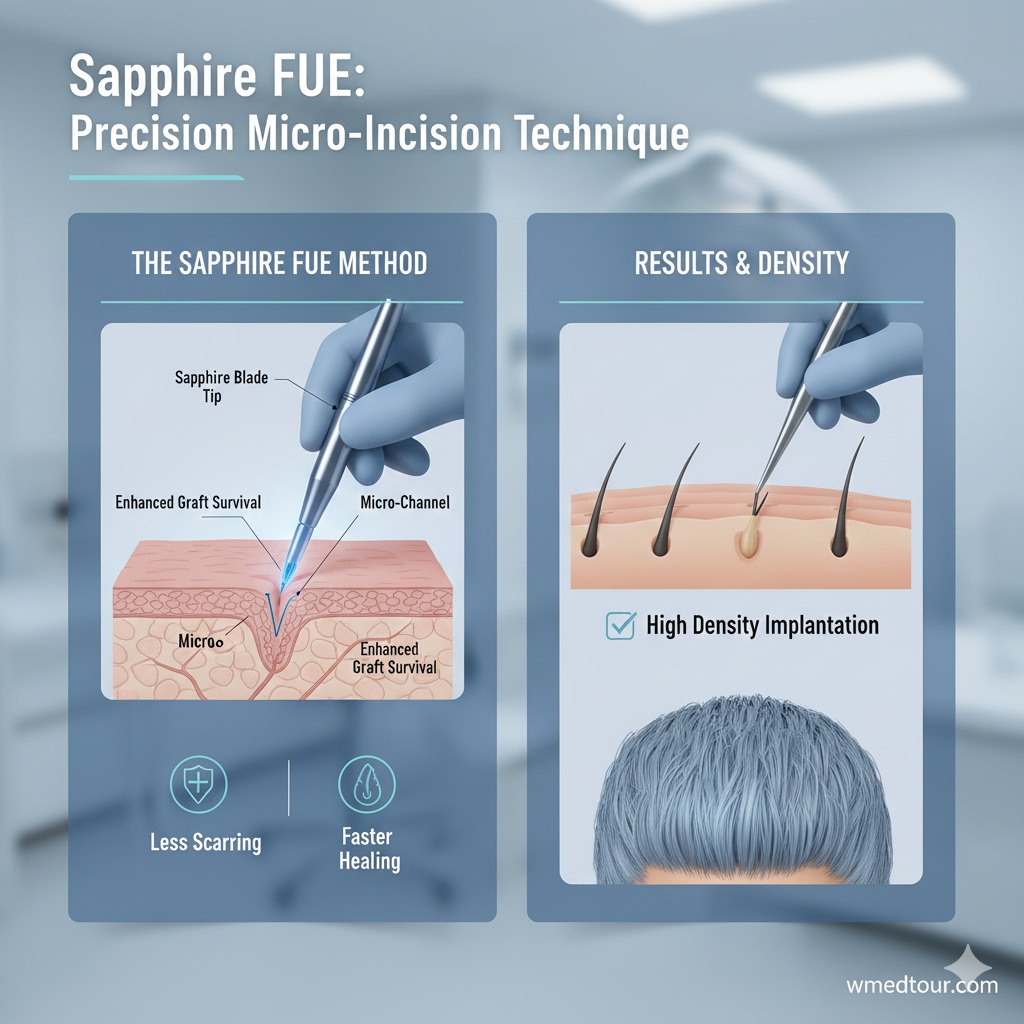
📊 Comparison: FUE vs. DHI at a Glance
| Feature | FUE Process | DHI Process |
|---|---|---|
| Surgical Tools | Micro-punch & Blades | Choi Implanter Pen |
| Graft Handling | Stored in Solution | Immediate Implantation |
| Average Cost | Moderate | Higher |
| Best For | Large Bald Areas | Precision & Density |
👥 Who is This For?
Indeed, not every individual experiencing hair loss is a candidate for surgery. To clarify, you must have a stable donor supply. If your loss is caused by temporary factors like stress, surgery may not be necessary. However, if you suffer from permanent male or female pattern baldness, this hair transplant procedure step by step offers a lifelong solution. Furthermore, patients should have realistic expectations regarding the final density. If you are unsure, our about-us page details how we help patients find the right path.
🩹 The Recovery Guide: Success After Surgery
Surviving the surgery is only half the battle. Subsequently, the way you treat your scalp determines the final success rate. For additional tips, browse our faq section regularly.
🚿 The First 48 Hours
Initially, you must protect the recipient area from any physical contact. For instance, do not wear hats or touch the grafts with your fingers. During sleep, use a travel pillow to keep your head elevated. This position effectively reduces swelling. In addition, avoid any strenuous activity that could raise your blood pressure. If you notice minor spotting, do not worry, as this is a normal part of the healing process.
🧴 Day 3 to Day 10: Washing Routine
After the initial two days, you can begin the gentle washing routine. First, apply a moisturizing lotion or foam provided by the clinic. Let it sit for 30 minutes to soften the scabs. Following this, rinse with lukewarm water using a very low pressure. Finally, use a pH-neutral shampoo. By day ten, most of the scabs should fall off naturally. If they persist, do not pick them, as you might pull out the underlying graft.
🏋️ Month 1 and Beyond
By the end of the first month, you can usually resume heavy exercise. Nevertheless, you should still avoid direct sunlight on the scalp. Use a high-SPF sunscreen or a loose-fitting hat if you go outdoors. Moreover, you might notice the “shock loss” phase where the transplanted hairs fall out. Rest assured, this is perfectly normal. The follicles are simply preparing for a fresh growth cycle that starts around the third month.
🌟 Patient Case Study: Sarah’s Journey
Sarah, a 42-year-old teacher, struggled with thinning hair at the temples. After years of using powders, she sought a permanent fix. She opted for the DHI hair transplant procedure step by step because it allowed her to keep her long hair intact. Initially, she felt nervous about the recovery. However, by following our guide, her healing was seamless. Today, Sarah enjoys a full hairline that looks entirely natural. Her story highlights why choosing the right method is essential for long-term satisfaction. You can find similar success stories via our expert doctor filters.
💵 Cost Analysis Table (Global Estimates)
Financial planning is vital for any medical journey. Consequently, we have compared the average costs of 3,000 grafts across popular destinations.
| Region | Average Price (USD) | Value Factor |
|---|---|---|
| Western Europe | $9,000 – $15,000 | High Overhead |
| Turkey | $2,200 – $4,000 | All-Inclusive Packages |
| Iran | $1,200 – $2,800 | Superior Expertise/Price |
To explore affordable options, visit Iran medical tours or check all-locations for global clinics.
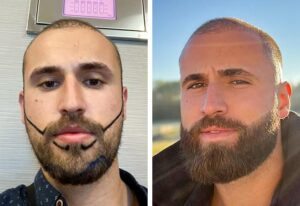 🏖️ Recovery & Tourism: A Healing Vacation
🏖️ Recovery & Tourism: A Healing Vacation
Many patients choose to travel abroad for their hair transplant procedure step by step. This trend is known as medical tourism. By choosing a destination like Iran or India, you can access world-class surgeons at a fraction of the price. Furthermore, the recovery period becomes a vacation. You can explore local heritage and enjoy five-star hospitality while your scalp heals. Ultimately, this approach reduces the stress of surgery and makes the entire process more enjoyable.
🏥 Medical Disclaimer
Please note that the content provided is for informational purposes only. It is not a substitute for professional medical advice from a licensed physician. Always consult with a surgeon before deciding on a procedure. Success rates can vary based on individual health factors. For more details on our standards, visit the articles category.
❓ Frequently Asked Questions
1. How long does the hair transplant procedure step by step take?
Typically, the process lasts between 6 and 9 hours depending on the number of grafts.
2. Is the surgery performed under general anesthesia?
No, doctors use local anesthesia. Therefore, you remain awake and comfortable throughout the session.
3. When can I see the final growth?
Usually, the final results are visible between 12 and 15 months after the operation.
4. Are the results of a hair transplant permanent?
Yes, because the hair is taken from the permanent donor zone, it will continue to grow for a lifetime.
5. Can I exercise after the procedure?
You should avoid heavy lifting for at least two weeks. However, light walking is permitted after 48 hours.
6. Will I have visible scars?
With FUE and DHI, there are no linear scars. Only tiny, undetectable dots remain in the donor area.
7. Does the hair transplant procedure step by step work for gray hair?
Absolutely. Gray hair can be transplanted just like pigmented hair, and the results look very natural.
8. What is the success rate of FUE?
Generally, the success rate for graft survival in FUE is around 90-95% when performed by experts.
9. Can women get a hair transplant?
Yes, women often benefit from these procedures, especially for thinning parts or high hairlines.
10. How soon can I travel back home?
Most patients are fit to fly 48 hours after the procedure. However, a 3-4 day stay is recommended for the first wash.
11. Should I take medications after the transplant?
Doctors often prescribe antibiotics and anti-inflammatories. Additionally, they may suggest Finasteride or Minoxidil to maintain existing hair.
12. How do I choose the right clinic?
You should check doctor profiles, read reviews, and verify the clinic’s international certifications.
